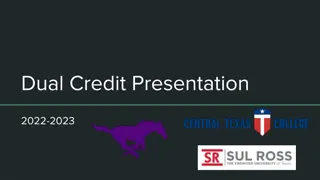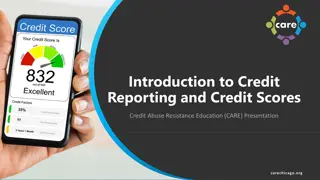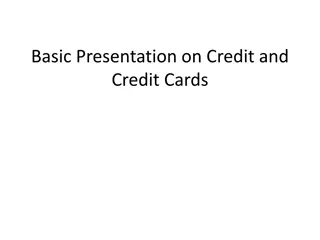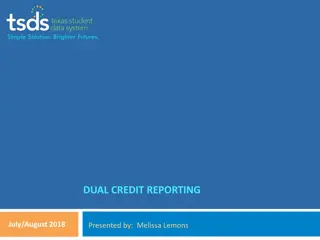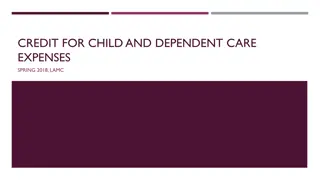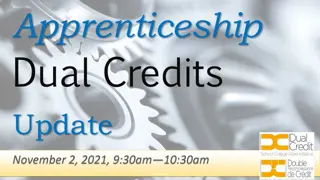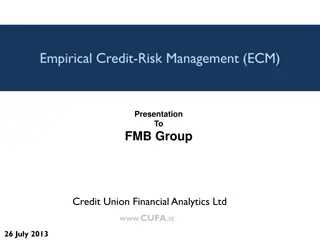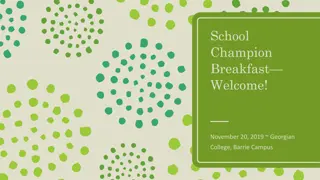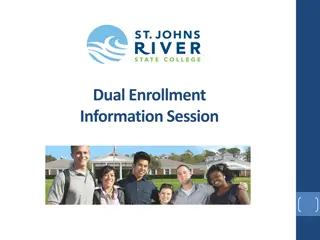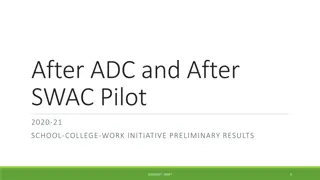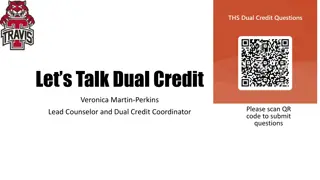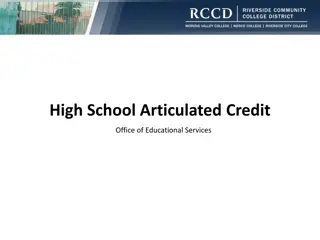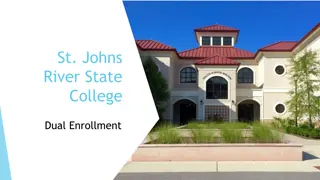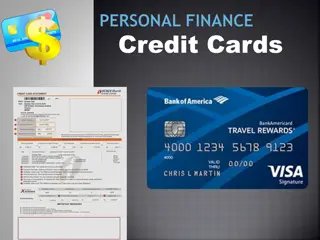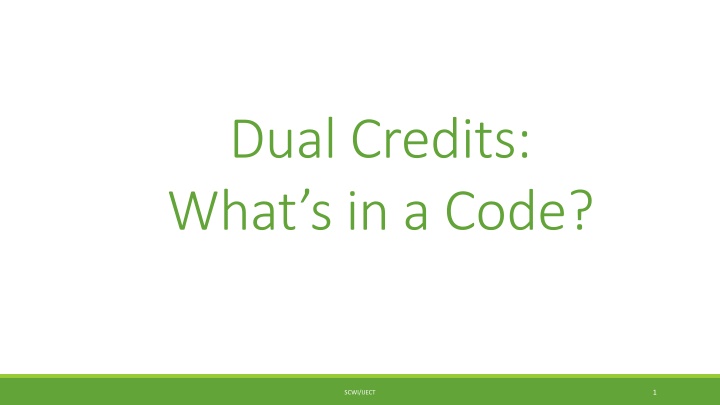
Discover Dual Credits in Education System
Explore the world of dual credits in education through details on course offerings, enrollment statistics, decision-making processes, and access to course codes for college-delivered and team-taught dual credits. Learn how Regional Planning Teams determine course availability and how to find relevant information for your students.
Download Presentation

Please find below an Image/Link to download the presentation.
The content on the website is provided AS IS for your information and personal use only. It may not be sold, licensed, or shared on other websites without obtaining consent from the author. If you encounter any issues during the download, it is possible that the publisher has removed the file from their server.
You are allowed to download the files provided on this website for personal or commercial use, subject to the condition that they are used lawfully. All files are the property of their respective owners.
The content on the website is provided AS IS for your information and personal use only. It may not be sold, licensed, or shared on other websites without obtaining consent from the author.
E N D
Presentation Transcript
Dual Credits: What s in a Code? 1 SCWI/IJECT
https://www.scwi.ca/scwi/policies.php 2 SCWI/IJECT
Sample 9 (p.36) shows an OST with both team- taught and college-delivered dual credits. Page 11 has details on showing partial completion in multiple-credit college-delivered dual credit courses. Page 12 outlines how to decide which credits to record when students earn more than the maximum of 4 external credits (college-delivered dual credits plus external music) Page 12 indicates the entry in the Note column for team-taught dual credits. https://www.ontario.ca/page/ontario-student- transcript-manual 3 SCWI/IJECT
20,508 students were enrolled in dual credits in 2022-23 4 SCWI/IJECT
Who decides which courses will be offered? Regional Planning Teams (RPTs) jointly decide which courses to offer to students in their area. RPTs then submit proposals annually for approval to offer those courses. RPTs always include both college and district school board members. If you have suggestions around specific types of courses that you think would be valuable for your students, get in touch with your board representative to explore possibilities. 5 SCWI/IJECT
How do I know which dual credits are available to my students? Your board representative on the RPT will let you know which courses are available to your students and will provide details including when and where the courses will take place course delivery approach how many seats are available which course codes will be used 6 SCWI/IJECT
Where do I find course codes for college- delivered dual credits? For college-delivered dual credits, course codes should already be available in your SMS. You can also access the latest lists on the School-College-Work Initiative web site: http://scwi.ca/scwi/coursecodes.php If you can t find a code for a course your student is taking, contact your board SCWI lead. 7 SCWI/IJECT
Where do I find course codes for team- taught dual credits? For team-taught dual credits, the course code you will use is the course code for the Ontario curriculum course that is being team taught. 8 SCWI/IJECT
College-delivered vs team-taught TPC4T MCT4C All instruction done by college instructor/professor Some instruction by secondary teacher, some instruction by college instructor/professor. Complete college and secondary school curriculum delivered All Assessment and evaluation done by college instructor/professor Assessment and evaluation of secondary school curriculum by secondary school teacher with passing grade of 50% Assessment and evaluation of college curriculum by college instructor/professor with passing grade as high as 70% TPC4T Passing grade 60% Maximum of 4 can count on OST Optional credits only No limit to number of team-taught dual credits Can be compulsory or optional Grade recorded on OST will match grade achieved on college record. Grade recorded on OST may not match grade achieved on college record 9 SCWI/IJECT
Achievement in dual credits counts towards two different credentials College-delivered college course: TPC4T Team-taught college course: MCT4C Special ministry course code Ontario curriculum course code OST OST TPC4T CAMBRIAN C: Exploring Dental Assisting DEN1165 MCT4C Mathematics for College Technology (dual credit) Course delivery type: Regular day or DC: On-line Course delivery type: DC: team-taught coll crs or DC: team-taught apprent crs No entry in Note column T in Note column College Record Exploring Dental Assisting DEN1165 College Record Technical Mathematics MAT8001 10 SCWI/IJECT
How are dual credits recognized in OnSIS, postsecondary applications and on OSTs? Identification by course code and entries in Note column. Course titles are not included. College-delivered college courses: Identified by special course codes ending in 4T or 4Y Team-taught dual credits: Identified only by T in Note column Course code is an Ontario curriculum code If no T , then course isn t recognized as a dual credit 11 SCWI/IJECT
College-delivered dual credit course codes table 12 SCWI/IJECT
College-delivered dual credit course codes table Old Ministry Course Code Ministry Course Code College Course Code Credit Value Start Date (MM/DD/YYYY) Close Date (MM/DD/YYYY) Passing Grade Ministry Course Title College Course Title Hours 13 SCWI/IJECT
College-delivered dual credit course codes table Old Ministry Course Code Ministry Course Code College Course Code Credit Value Start Date (MM/DD/YYYY) Close Date (MM/DD/YYYY) Passing Grade Ministry Course Title College Course Title Hours PPS4T Mental Health in Law Enforcement SAULT C: Body Structure and Function II PSW118 PSW118 1.00 2020-11-01 60 45 Ministry Course code: PPS4T For the most part, the first three characters are similar to the first three characters of Ontario curriculum courses. This example is from the general area of Health and Physical education. All college-delivered dual credits are Grade 12 courses. All college-delivered college courses end with T ; college-delivered Level 1 apprenticeship courses end with Y . They do not have a destination code (C, M, U, etc.). Colleges that use an admission average will include marks in these courses in their calculations. For applications through OCAS or OUAC, it is this code, not the course title that is transmitted. OCAS updates their database every time a new list is distributed. OUAC receives the lists but does not update their list of courses automatically since few university applicants would have a dual credit. OUAC will update their list on request for individual courses. 14 SCWI/IJECT
College-delivered dual credit course codes table Old Ministry Course Code Ministry Course Code College Course Code Credit Value Start Date (MM/DD/YYYY) Close Date (MM/DD/YYYY) Passing Grade Ministry Course Title College Course Title Hours PPS4T Mental Health in Law Enforcement SAULT C: Body Structure and Function II PSW118 PSW118 1.00 2020-11-01 60 45 College course title: SAULT C: Body Structure and Function II PSW118 The title always includes the name of the college. It s therefore important to select the right college when you are creating this course in your system. If you don t, there is a risk that the passing grade will be different resulting in credits not earned when they should be or credits earned when they should not. The student s timetable, report card and ultimately his/her OST will include all of this information. If the student took a dual credit at Fanshawe but the OST indicates a course from Cambrian, the wrong code has been selected. 15 SCWI/IJECT
College-delivered dual credit course codes table Old Ministry Course Code Ministry Course Code College Course Code Credit Value Start Date (MM/DD/YYYY) Close Date (MM/DD/YYYY) Passing Grade Ministry Course Title College Course Title Hours PPS4T Mental Health in Law Enforcement SAULT C: Body Structure and Function II PSW118 PSW118 1.00 2020-11-01 60 45 Credit value: 1.00 The credit value towards an OSSD is determined by the Ministry of Education. With very few exceptions, all college-delivered college courses have a credit value of 1.00. The information from this OnSIS table is built in to your school s SMS. If the student earns a mark at or higher than the passing grade, the credit value will automatically be inserted in the student s record. 16 SCWI/IJECT
College-delivered dual credit course codes table Old Ministry Course Code Ministry Course Code College Course Code Credit Value Start Date (MM/DD/YYYY) Close Date (MM/DD/YYYY) Passing Grade Ministry Course Title College Course Title Hours PPS4T Mental Health in Law Enforcement SAULT C: Body Structure and Function II PSW118 PSW118 1.00 2020-11-01 60 45 Passing grade: 60 The passing grade for a college-delivered dual credit is set by the college. Since we want students to have an authentic college experience, it is important that students who earn a credit for successfully completing a college course meet the same standard as all college students. The passing grade may be as low as 50% or as high as 70%. Dual credit students who earn a mark below the passing grade will not receive a credit for the course. That may mean that the OST will show a mark of 58% for example, in this course, but the credit value will be 0. Partial credits are not available for dual credit college courses. For dual credit Level 1 apprenticeship courses, partial credits can be granted. Full disclosure applies to dual credits. 17 SCWI/IJECT
College-delivered dual credit course codes table Old Ministry Course Code Ministry Course Code College Course Code Credit Value Start Date (MM/DD/YYYY) Close Date (MM/DD/YYYY) Passing Grade Ministry Course Title College Course Title Hours PPS4T Mental Health in Law Enforcement SAULT C: Body Structure and Function II PSW118 PSW118 1.00 2020-11-01 60 45 Hours: 45 This isn t something you ll need to be concerned about but it is important to know that in order for a dual credit to have a credit value of 1.0 towards the OSSD, there must be at least 42 hours of classroom instruction. That coincides with the average length of instruction in college courses. There is an expectation that students would be spending a significant additional amount of time outside of class in a college course. When new dual credit courses are introduced, and new course codes are required, the Ministry of Education uses the number of hours of instruction in their determination of credit value. 18 SCWI/IJECT
College-delivered Level 1 apprenticeship dual credit: what s different? Old Ministry Course Code Ministry Course Code College Course Code Credit Value Start Date (MM/DD/YYYY) Close Date (MM/DD/YYYY) Passing Grade Ministry Course Title College Course Title Hours TTE4Y Automotive Service Technician Level 1 App: Automotive Service Technician 310S 310S 2.00 2015-07-01 50 240 Ministry Course code: TTE4Y Note that the code ends with Y, rather than the T we saw with college courses. College course title: Level 1 App: Automotive Service Technician 310S Note that the college name does not appear. However, it is important to select the correct college name in your SMS because the passing grade is not the same for all colleges. The title Automotive Service Technician is the title used by the Ministry of Labour, Training and Skills Development (MLTSD) for this trade. The code 310S is the code that MLTSD uses for this trade. 19 SCWI/IJECT
College-delivered Level 1 apprenticeship dual credit: what s different? Old Ministry Course Code Ministry Course Code College Course Code Credit Value Start Date (MM/DD/YYYY) Close Date (MM/DD/YYYY) Passing Grade Ministry Course Title College Course Title Hours TTE4Y Automotive Service Technician Level 1 App: Automotive Service Technician 310S 310S 2.00 2015-07-01 50 240 Credit value: 2.00 The credit value towards an OSSD is determined by the Ministry of Education. With very few exceptions, all college- delivered Level 1 apprenticeship courses have a credit value of at least 2.00. Passing grade: 50 For most Level 1 dual credits, the passing grade is 60%. As with college courses, students must achieve at or above the grade on this table in order to earn any credits, including partial credits. Hours: 240 Typically, students would spend at least two full periods per day in a Level 1 dual credit. Those two periods would count towards FTE in the same way as any other two-credit secondary school course. 20 SCWI/IJECT
College-delivered Level 1 apprenticeship dual credit: what s different? Old Ministry Course Code Ministry Course Code College Course Code Credit Value Start Date (MM/DD/YYYY) Close Date (MM/DD/YYYY) Passing Grade Ministry Course Title College Course Title Hours TTE4Y Automotive Service Technician Level 1 App: Automotive Service Technician 310S 310S 2.00 2015-07-01 50 240 Partial credit Since Level 1 dual credits have a credit value of at least 2.0, policy allows students to earn partial credits if they do not successfully complete all components of the course at that level. The dual credit teacher and the college instructor will jointly determine how many credits to award. In your SMS, you can enter any amount up to the full amount, as long as the student grade entered is at the passing grade or higher. In a case where a student is granted fewer than the total number of possible credits for a Level 1 apprenticeship dual credit, the SMS will automatically insert the word partial after the name of the course on the student s OST. Level 1 App: Automotive Service Technician 310S (partial) The student s college record would indicate that the student was unsuccessful in earning his/her Level 1. 21 SCWI/IJECT
Incorrect Codes: Whats the Risk? Incorrect passing grades might lead to students not earning credits when they should or earning credits when they should not. Incorrect credit values: Students may receive too few or too many credits The wrong course title may appear on the OST. The wrong college name may appear on the OST. If team-taught and not flagged, course won t be identified as a dual credit 22 SCWI/IJECT
Checking for Errors: Timetable Dual credit courses should appear on students timetables. If the dual credit course doesn t appear on the timetable at all, then enrolment in that course will not count towards the student s FTE status and the course won t be included in your data transmission to OCAS. If the course is team-taught: course delivery type must be either DC: team-taught coll crs or DC: team-taught coll apprent crs course title must be an Ontario curriculum course with the appropriate Ontario curriculum course code code cannot end with 4T or 4Y . If the course is college-delivered: course delivery type either Regular day or DC:On-line course code will end with 4T for a college course Course code will end with 4Y for a Level 1 apprenticeship dual credit 23 SCWI/IJECT
Checking for Errors: OCAS transmission If the student took a team-taught dual credit: course code cannot end in 4T or 4Y course code must be an Ontario curriculum code must be a T in the Note column on the OST If the student took a college-delivered dual credit: course code must end in 4T or 4Y . course code for a college-delivered college course must end with 4T course code for a college-delivered Level 1 apprenticeship dual credit must end with 4Y 24 SCWI/IJECT
Checking for Errors: OST If the student took a team-taught dual credit: course code cannot end in 4T or 4Y code must be an Ontario curriculum course code must be a T in the Note column dual credit will appear after the title of the Ontario curriculum course If the student took a college-delivered dual credit: course code must end in 4T or 4Y cannot be a T in the Note column dual credit should not appear after the title of the course. For a college-delivered college course, the name of the college will be part of the course title. For a college-delivered Level 1, the name of the college will not appear in the course title. 25 SCWI/IJECT
Contacts Contacts Please contact Ministry of Education staff for Course Codes related questions Daniel.denomme@ontario.ca (English-language) Lynn.grittani@ontario.ca (French-language) 26 SCWI / IJECT




